

Against Empathy: Why Design Thinking Demands More. In the September issue of HBR, Jon Kolko writes about building a design-centered corporate culture by applying the core principles of design thinking.

This is a lovely premise, and Kolko provides insight into the methods of design thinking and the challenges that organizations face in adopting it. It is also a somewhat pedestrian premise. What stuck most in my mind, as I read it, was actually a relatively small point that I have previously thought of as table-stakes—and this is the importance of empathy. I never thought I would write to stand up against empathy. I’ve built my career advocating for the value of empathy. However, I think that a pat reliance on human empathy and bread-and-butter experience design minimizes the challenges and opportunities that exist for design thinkers today. At Continuum, we live, breathe and sell the power of empathy. Design Thinking in Education: Empathy, Challenge, Discovery, and Sharing. Five Innovations to School Design Thinking Process Yield Powerful Results.
I am engaged in several year-plus design thinking efforts with schools and districts that are sincerely committed to finding and implementing user-centric solutions that create lasting value.

The basic processes are those developed by the Stanford d.school and the Mount Vernon Institute for Innovation, along with others. At the Tilton School in New Hampshire (HT Kate Saunders and Peter Saliba as co-developers of these innovations) we have created or introduced at least five new elements to the design process that are proving extremely valuable. Leading With Design Thinking.
I spent a great deal of time at the end of Term 2 focusing my thoughts on how Design Thinking applies to educational leadership.
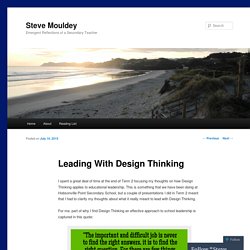
This is something that we have been doing at Hobsonville Point Secondary School, but a couple of presentations I did in Term 2 meant that I had to clarify my thoughts about what it really meant to lead with Design Thinking. For me, part of why I find Design Thinking an effective approach to school leadership is captured in this quote: Design Thinking is a Human-centred process (or mindset) for dealing with open, complex problems. Now, to me, ‘open, complex problems’ sums up education in a nutshell. And the focus on empathy that a Design Thinking approach brings is ideal for focusing on the right question – the cause of issues arising rather than the symptoms. Innovate from the outside in. In a local school near me, the staff has spent a couple of years iteratively redesigning the way they prepare students to change classes at the end of the year.
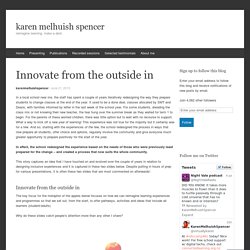
It used to be a done deal, classes allocated by SMT and Deans, with families informed by letter in the last week of the school year. For some students, dreading the class mix or not knowing their new teacher, the fear hung over the summer break as they waited for term 1 to begin. For the parents of these worried children, there was little option but to wait with no recourse to support. Leading With Design Thinking. Design Thinking: Not Just Another Buzzword. Does design thinking run the risk of being the next buzzword in K-12 education?
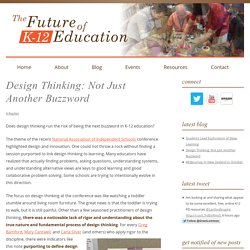
The theme of the recent National Association of Independent Schools conference highlighted design and innovation. One could not throw a rock without finding a session purported to link design thinking to learning. Many educators have realized that actually finding problems, asking questions, understanding systems, and understanding alternative views are keys to good learning and good collaborative problem solving. Some schools are trying to intentionally evolve in this direction. The focus on design thinking at the conference was like watching a toddler stumble around living room furniture.
Discipline, there were indicators like this note purporting to define design thinking without mentioning either users or empathy, perhaps the two most key elements of the process. iLearn: Design Thinking in Action. After going through a design-type process to redesign what learning looked like across two of our learning commons (see post here) with 3 other teachers, we decided to use this process with some of our students when we came to the project phase of our learning.
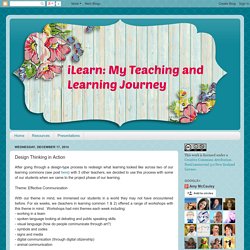
Theme: Effective Communication. DesignThinkingLitCritique_2014.pdf. Design Kit. "Don't think of it as failure, think of it as designing experiments through which you’re going to learn.
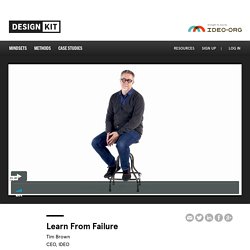
" Failure is an incredibly powerful tool for learning. Designing experiments, prototypes, and interactions and testing them is at the heart of human-centered design. So is an understanding that not all of them are going to work. As we seek to solve big problems, we’re bound to fail. But if we adopt the right mindset, we’ll inevitably learn something from that failure. HCD Connect. Design Kit. Design Thinking for Educators. Dispositions of thinking, from design thinking.
The problem with "design thinking" is that everyone thinks they do it already, but they all do something different.
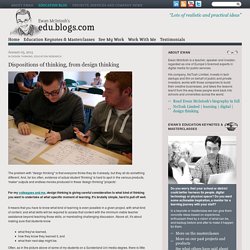
And, far too often, evidence of actual student 'thinking' is hard to spot in the various products, 'maker' outputs and endless movies produced in these 'design thinking' 'projects'. For my colleagues and me, design thinking is giving careful consideration to what kind of thinking you want to undertake at what specific moment of learning. It's brutally simple, hard to pull off well. It means that you have to know what kind of learning is even possible in a given project, with what kind of content, and what skills will be required to access that content with the minimum viable teacher assistance beyond teaching those skills, or marshalling challenging discussion. Above all, it's about making sure that students know what they've learned,how they know they learned it, andwhat their next step might be. Digital Tools for Design Research. Design research here is not any one thing, and it’s informed by the passion and skills of our teams as much as any organizational process.
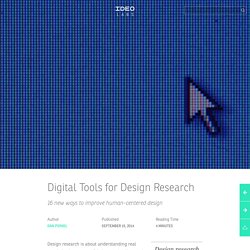
Design research is about understanding real people in the context of their everyday lives and then using what we learn to inspire our work. This loose definition may conjure up a narrow set of methods, but at IDEO, we’re broad in our approach: Design research here is not any one thing, and it’s informed by the passion and skills of our teams as much as any organizational process. Glancing across the office, I see a colleague who is an incredible photographer and uses her craft to deepen our insights. In the other direction is a design researcher who creates amazing experience prototypes that help us learn about people and provide feedback on new concepts. In my case, I’ve adapted my background in applying sociological and anthropological methods in order to understand how people use digital media.
The Tools Use cases from typeform.com 1. 2. 3. 4. Innovators_Guidebook_-_Ideate_and_Prototype. Want A Crash Course In Stanford’s Design Thinking? Here it is for free (Pt. 1 Empathy) The Institute of Design (D.School) at Stanford has become one of the most talked about institutions recently because of the methodology they are spreading around the world to improve our lives through a collaborative approach that inspires human centered innovations.
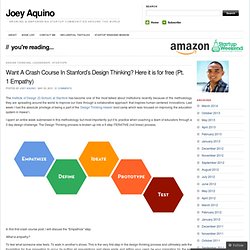
Last week I had the absolute privilege of being a part of the Design Thinking Hawaii boot camp which was focused on improving the education system in Hawai’i. I spent an entire week submersed in this methodology but most importantly put it to practice when coaching a team of educators through a 3 day design challenge. The Design Thinking process is broken up into a 5 step ITERATIVE (not linear) process.
In this first crash course post, I will discuss the “Empathize” step. Innovators_Guidebook_-_Ideate_and_Prototype. …the 4th Word. This is a quick post… It is all about the 4th word. The 4th word that comes after the following: How Might We… The 4th word to me can really lift up and energize your brainstorm. It can open the floodgates for some major solution possibilities… But wait, I need to slow down and not get ahead of myself (bad habit of running to the solution).
The 4th word that follows “How Might We” is most important in my opinion because it gets the ball rolling. A Riff & Ramble on HMW… Last night I thankfully caught a few tweets between some awesome K12dters Down Under… Philippa N Antipas Steve Mouldy 1st Follower Reading the tweets and also sharing a couple thoughts with Philippa inspired me to riff & ramble once again about the HMW…question.
I have written previously about the power & possible problems with starting a dt challenge with a How Might We…question in the following posts: #DEEPdt Challenge Unpack It Don’t Engrave It and The 4th Word. In the above posts, I have shared some thoughts about the How Might We… and with Philippa’s storify (posted at bottom of this blog post) conversation with Steve & 1st Follower, I realized another aspect of why I will continue to resist starting DEEP design thinking challenges with a HMW… question.
The framing of the HMW… narrows the field of scope and inserts a guidepost for the designers to keep them in check. What is Design Thinking. LUMA Institute. Internet Catalogue. Design Thinking in Schools K12 Directory. An approach for our world. 2010_SSIR_DesignThinking.pdf. Beginner's Guide to K-12 Design Thinking. IDESiGN. DTK12chat. Please join us for a weekly conversation about design thinking in K12 education. We will have a variety of moderators with a wide range and depth of design thinking experiences. Each week, we will connect the dots to the design thinking methodology and how it can and will play a bigger role in today's K12 educational arena via a twitter chat.
The hashtag to bookmark is #DTK12chat. Cooper Hewitt Smithsonian Design Museum. Ready, Set, Design is one of our favorite group activities, for adults and kids alike, at Cooper-Hewitt. It’s a highly adaptable design challenge that can jump-start collaborative and creative thinking in any group. We use it with kids’ groups at the Museum, for internal staff meetings, and even at industry conferences and summits we host. The activity is such a success with our participants that we’ve gotten a lot of requests for a how-to guide. Here it is!
We created this short instructional video and accompanying PDF that explain Ready, Set, Design for group leaders. D.School Slide Shots & Mind Maps. The Nueva School - Mission and Philosophy. The Nueva School is an internationally recognized independent school PK-9 expanding to PK-12 serving gifted and talented students since 1967. The school is a three-time winner of the US Department of Education National Blue Ribbon Award, winner of the American Institute of Architects Award for School Design and Sustainability, recognized as an Apple Distinguished Program, appointed an Ashoka Changemaker School, a co-founder of the Common Ground Speaker Series, sponsor of the Innovative Learning Conference, and was highlighted by the Pulitzer Prize-winning and New York Times best-selling author Thomas Friedman in his recent book That Used to Be Us in the chapter “Average Is Over”. Nueva is located in the neighboring towns of Hillsborough and San Mateo equidistant between San Francisco and Silicon Valley in the Bay Area of Northern California.
Vision The Nueva School uses a dynamic educational model to enable gifted students to learn how to make choices that will benefit the world. Mount Vernon Presbyterian School. iDiploma: It’s about VERBS! We launched our Innovation Diploma at Mount Vernon Presbyterian Upper School! Here’s the speech I shared, and the slides to accompany: One of the reasons we’re here today is to honor these students who have taken a risk, and chosen themselves to do something awesome. Which is definitely worth the early morning, schedule reshuffling many of us did in order to be here. How might we use e-tools to amplify the learning in Design Thinking?
In teaching, if an e-tool will amplify the learning we are aiming for then it is worth using that tool. Frog_collective_action_toolkit.pdf. Why DEEPdt as a design thinking process? « DEEP Design Thinking. The below post was written almost a year ago (I have made a couple edits- MoVe- Moment of Visible Empathy being the most prominent change and added some of the latest graphics collaboratively created for DEEPdt). Also, during the #FUSE14 experience on June 25-26, the DEEPdt Playbook & FlashLab (DEEPdt crash lab) will be launched to the masses. Problem Finding and Student Ownership. This term I have been co-teaching a module with Pete McGhie that has had students focusing on our developing neighbourhood, Hobsonville Point, as a place. How To Do Design Thinking — What I Learned Building… David Kelley: The first step in the Design Thinking process is what we call the Understand phase: if you’re going to work in a certain area you really need to talk to experts.
What is Design Thinking, Really. If you’re a businessperson or someone interested in understanding how to facilitate innovation, you’ve probably heard of “design thinking” by now. Coined by IDEO’s David Kelley, the term refers to a set of principles, from mindset to process, that can be applied to solve complex problems. The Four Phases of Design Thinking - Warren Berger. By Warren Berger | 10:54 AM July 29, 2010 What can people in business learn from studying the ways successful designers solve problems and innovate? On the most basic level, they can learn to question, care, connect, and commit — four of the most important things successful designers do to achieve significant breakthroughs. Frog Collective Action Toolkit. A More Powerful Inquiry. One of my core educational values is Curiosity. Yet, in the past I have fallen into the trap of Inquiry = Research instead of a more open curious discovery process.
One of the biggest pedagogical changes I have made was when I shifted to an inquiry approach that was about allowing students more time to dwell, think and discuss their questions on whatever the topic of study was at that time. NZC and Design Thinking Part 2. While last week was about deconstruction and reconstruction of the New Zealand Curriculum, this week has been about gaining clarity in our process.
NZC and Design Thinking Part 1. Design Thinking Teacher Training Video // Part 1 of 2. Maximizing Your Students' Creative Talent: Co Barry at TEDxDenverTeachers. About IDEO. Hack Your Classroom - Week Three: Introduction to Design Thinking. TEDxLondon - Ewan McIntosh. A More Powerful Inquiry. The Design Thinking School \ What we do. Ewan McIntosh on Design Thinking for Librarians' and Teachers' professional development.